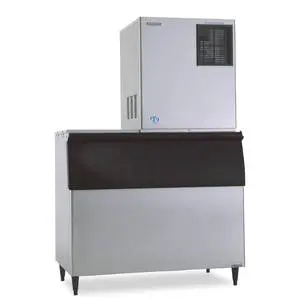You've decided it is time to purchase an ice machine. Whether this is your first ice maker, a replacement or an addition to the ice making equipment you already have; these tips should help you select the perfect ice machine to meet your needs.
What Type of Ice Do You Need?
While various manufacturers coin terms like tube ice, crescent cube, nugget, top hat, and more, to describe their machine's yield, there are three basic types of commercial ice: cubed, flaked or crushed, and nugget.
Typically nugget and cubed ice are used for beverages. Ice nuggets, made by extruding and freezing slushy flake ice into small pieces, are used primarily to cool soft drinks. Crushed ice consists of small, irregular pieces made by crushing larger chunks of ice. Cubed ice has a slower melting time and better displacement in a container thus, contributing to increased profits from the service of both soft and mixed drinks. More than 80% of commercial ice consumption in the US is in the cubed form.
Flaked ice lends itself better to fast cooling and use in displays such as salad bars and seafood cases. Flaked ice is the most economical to produce and also gives the customer the perception of freshness.
Size Matters for Ice Machines
As a rule of thumb, full service restaurants use 1.7lb of ice per person, fast food restaurants use 0.9lb per person, and cocktail lounges use 3lb per person. In convenience stores or other beverage only situations where customers dispense their own ice, a 12oz beverage will consume 4oz of ice, 7oz for a 20oz cup and 10oz of ice in a 32oz cup. For more information typical daily ice consumption, please review What Size Ice Machine Do I Need.
The following are examples of putting this into practice:
- A full service restaurant anticipating 150 customers at lunch and 100 customers at dinner would use a minimum of 425lb of ice per day. That's – 1.7lbs x 250 people = 425lbs of ice needed per day.
- For new facilities: Use your seating capacity and the amount of times you expect to fill each seat per day to determine your expected daily customer count.
- Example: Your new full service BBQ bar and grill has a dining room seating capacity of 65 people which you expect to fill 3 times a day. Your bar will seat 15 people and you expect to fill those seats 4 times during the evening. The math for this scenario: (65 person capacity x 3 fills x 1.7lbs) + (15 person bar capacity x 4 fills x 3lbs per person) = 511.5lbs of ice per day.
Also, don't forget that you are making an investment in a piece of equipment which will be with you for many years as your business succeeds and grows. It would be a wise choice to select a commercial ice machine that will be able to keep up with growing capacity. For customer satisfaction and food safety reasons, a commercial operation cannot afford to run out of ice.
When looking at production figures, it is best to use the test standards set forth by the Air-Conditioning and Refrigeration Institute (ARI) of 90° F ambient air and 70° F water.
Ice Machine Requirements
The environment where your ice machine will be located is an important factor to consider. Different types of commercial ice machines have different space, airflow, drainage, and power requirements.
Air-cooled ice makers use the most energy but are usually less expensive initially than water-cooled models.
Water-cooled models are far more efficient, energy-wise, than air-cooled units and suitable for installation conditions where humidity and ambient air temperatures would virtually shut down an air cooled machine.
Remote air-cooled condensers transfer heat generated by the ice-making process to the outside of the building. Like water-cooled units, they move heat outside of AC controlled spaces and therefore do not increase air conditioning loads. Keep in mind, there are extra installation costs for running refrigeration lines to a remote location.
The amount of water used to make ice varies widely by manufacturer and model. To yield 100 pounds of ice, your ice machine will need 14 to 35 gallons of water depending on manufacturer. This is an important factor to consider where water costs are high. In the average US market, the cost for your ice machine will break down to 20% water and 80% electricity. Where water costs are higher, this ratio may be skewed.
Don't forget to select a location for the machine where the temperature will remain moderate throughout the year. This will help ensure there are no large spikes in energy costs, unexpected condensation, or freezing of the lines.
Energy Efficiency
Ice machine manufacturers are continually making each new release more energy efficient than the last. The key points to remember about energy efficiency for commercial ice makers are water costs and electricity costs. Water costs for an ice machine will typically around a quarter of the cost of the electrical costs but this ratio changes in markets where water costs are at a premium. We have a handy guide for helping selecting the right type of ice machine to maximize efficiency in your market..


